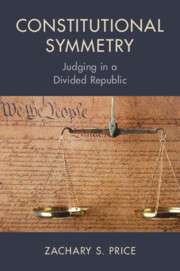The Volokh Conspiracy
Mostly law professors | Sometimes contrarian | Often libertarian | Always independent
How Symmetry Works—and Why It Is Already Part of Our Law
As my last post explained, my new book, Constitutional Symmetry: Judging in a Divided Republic, argues that judges should favor, when possible, constitutional understandings that offer valuable protections on opposite sides of key current divides, instead of just one side. Our current divided and acrimonious politics have produced a perilous tendency to politicize constitutional law and advance wholly partisan visions of the Constitution's meaning. Symmetric interpretation aims to counteract that tendency.
As I also explained, favoring symmetry is not a hard and fast rule; it is instead a preference. That means judges should favor symmetry only insofar as their primary interpretive commitments allow. In that sense, it resembles other second-order values in interpretation such as judicial restraint. A judge committed to restraint will invalidate democratic choices only when the Constitution is clear, but determining when the Constitution is clear requires a theory of interpretation that restraint alone cannot provide.
Symmetry is the same: because symmetry cannot override clear constitutional requirements, judges will each have to decide when their primary interpretive commitments do and do not permit symmetric understandings. Furthermore, the Constitution itself is not symmetric with respect to all conceivable ideological divisions. It is not neutral, for example, between representative democracy and dictatorship, nor between racial equality and racist oppression.
Within the range of reasonable disagreement, however, symmetry is a value that judges with different primary interpretive theories—whether originalist, formalist, pragmatist, living constitutionalist, or what have you—can equally embrace. It could thus provide a needed point of convergence among judges with differing primary commitments.
The same could be true, of course, of other second-order values like restraint, but as compared to such other possibilities, symmetry is the most important point of orientation in our time. In principle, restraint could help depoliticize constitutional law by leaving more choices to ordinary politics, but that would be true only if restraint were applied across the board—that is, if it were applied symmetrically.
Consider, for example, the reaction to Dobbs v. Jackson Women's Health Organization, the decision overturning the constitutional right to abortion. In some sense, the decision reflected commendable restraint: it returned an important question to the political process. But Dobbs's restraint appeared highly selective, and thus polarizing, when juxtaposed with contemporaneous decisions on matters such as affirmative action and gun control that effectively constitutionalized conservative policy preferences.
Symmetry, then, is a second-order interpretive value that responds directly to the polarized politics surrounding constitutional law. Why, though, should judges embrace this value? What theoretical considerations could support it? As I will explain in my next post, multiple strands of contemporary interpretive theory do in fact justify a preference for symmetry.
But the first point in symmetry's favor is simply that it is already part of our law. At oral arguments (and in law school classes), judges and lawyers routinely probe the validity of legal principles by positing scenarios that reverse the politics of the case at hand. Thus, for example, in a recent case involving a praying public-school coach, several justices raised questions about a hypothetical coach who carried the Ukrainian flag or knelt during the national anthem to protest police violence. Similarly, in a case about a California law barring sale of meat produced inhumanely outside the state, justices posed questions about analogous laws forbidding sale of goods produced by undocumented immigrants or by workers without the right to opt out of unions. Questions like these presume that a constitutional principle is more likely to be valid if it works in parallel across ideologically disparate situations.
Reasoning along these lines has appeared in some recent opinions too. Justices have complained in dissents about majority opinions "weaponizing" constitutional principles or ignoring "the law's demand for evenhandedness." Majority opinions, too, have touted the cross-ideological or cross-partisan benefits of their rulings. These assertions again reflect an implicit assumption that principles with symmetric rather than one-sided benefits are preferrable.
All these features of contemporary interpretive practice support a preference for symmetry, but so, too, do multiple—and otherwise divergent—aspects of contemporary interpretive theory, including political process theory, judicial role morality, and originalism (indeed, multiple forms of originalism). I'll elaborate on all those points in my next post.
To get the Volokh Conspiracy Daily e-mail, please sign up here.



Show Comments (5)